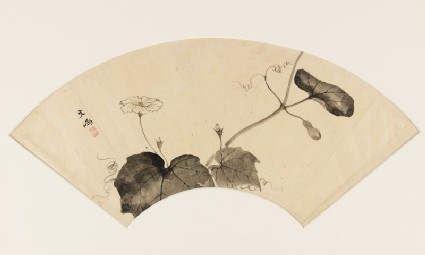Browse: 2185 objects
- Reference URL
Actions
Flowering gourd plant
-
Description
Little is known of the life of Oku Bunmei, except that he was one of the most talented pupils of the celebrated painter Maruyama Ōkyo. He displayed extraordinary control over the ink on his brush, seen here in the curling tendrils of the gourd plant. A master at transferring his careful observation of nature onto paper, he uses the minutest touch of bright yellow for the centre of the flower to enhance his variations in ink tone on the leaves, stems, and fruit.
-
Details
- Associated place
- Date
- c. 1800
- Artist/maker
-
Oku Bunmei (active c. 1790 - 1813, died 1813) (artist)Maruyama-Shijō School (active late 18th century - late 19th century)
- Material and technique
- ink and light colour on paper
- Dimensions
-
mount 40.5 x 55.5 cm (height x width)
painting 23.2 x 50 cm (height x width)
- Material index
- Technique index
- Object type index
- No. of items
- 1
- Credit line
- Purchased with the assistance of the Friends of the Ashmolean, and Mr and Mrs J. Hillier, 1973.
- Accession no.
- EA1973.18
-
Further reading
Katz, Janice, Japanese Paintings in the Ashmolean Museum, Oxford, with an introductory essay by Oliver Impey (Oxford: Ashmolean Museum, 2003), no. 25 on p. 98, p. 84, illus. pp. 98-99
Past Exhibition
see (1)-

Unfolding Nature: Images of Summer on Chinese and Japanese Fans
(from 10th Jul until 7th Oct 2012)
Location
-
- currently in research collection
Objects are sometimes moved to a different location. Our object location data is usually updated on a monthly basis. Contact the Jameel Study Centre if you are planning to visit the museum to see a particular object on display, or would like to arrange an appointment to see an object in our reserve collections.
Publications online
-

Japanese Paintings in the Ashmolean Museum
Bunmei has painted a flowering gourd plant in ink, with just a touch of yellow in the centre of the open blossom. The thin stems of the flowers grow out of a base of broad leaves, and a small gourd is seen forming on the right. Spirals of delicate calligraphic lines form the plant’s tendrils. Bunmei is obviously a master of controlling the ink through painting techniques, however here he combines this with an obviously careful study of nature.
Although one of Maruyama Ōkyo’s ten best pupils, details of Bunmei’s life are scarce and extant paintings by him are extremely few. He is especially well known as the writer of the biography of Maruyama Ōkyo, the Sensai Maruyama sensei den. In 1790, Bunmei was part of Ōkyo’s workshop that produced wall paintings for the Imperial Palace, and he also executed paintings for Daijōji temple of which a painting of wisteria and birds, an Important Cultural Property, is extant [published in Minamoto and Sasaki, 50, 191]. That composition displays the same controlled handling of the brush without making the composition look contrived as in the Ashmolean’s fan painting. Bunmei is able to show the real complexity of organic forms as they grow and twist, while managing to produce neat and pleasing pictorial compositions.
© 2013 University of Oxford - Ashmolean Museum

